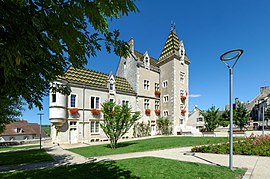Côte-d'Or
Côte-d'Or | ||
|---|---|---|
|
Top down: Town Hall | ||
|
Communes 698 | | |
| ^1 French Land Register data, which exclude estuaries and lakes, ponds and glaciers larger than 1 km2 | ||
Côte-d'Or (IPA: [kot dɔʁ]; which can be translated as "gold coast" or "gold region") is a département in the Bourgogne-Franche-Comté region of Northeastern France. In 2019, it had a population of 534,124.[3] Its prefecture is Dijon and subprefectures are Beaune and Montbard.
History
Côte-d'Or is one of the original 83 departments created during the
Geography
The department is part of the current region of Bourgogne-Franche-Comté. It is surrounded by the departments of Yonne, Nièvre, Saône-et-Loire, Jura, Aube, Haute-Saône, and Haute-Marne.
A chain of hills called the Plateau de Langres runs from north-east to south-west through the department to the north of Dijon and continues south-westwards as the
Rivers include:
- The Saône
- The Seine rises in the southern end of the Plateau de Langres.
- The Ouche rises on the dip slope of the escarpment and flows to the Saône via Dijon.
- The Armançon rises on the dip slope of the escarpment and flows north-westward.
- The Arroux rises on the dip slope of the escarpment at the southern end of the department.
Climate
The climate of the department is continental, with abundant rain on the west side of the central range.
Principal towns
The most populous commune is Dijon, the prefecture. As of 2019, there are 5 communes with more than 10,000 inhabitants:[3]
| Commune | Population (2019) |
|---|---|
| Dijon | 158,002 |
| Beaune | 20,551 |
| Chenôve | 14,025 |
| Talant | 11,713 |
| Chevigny-Saint-Sauveur | 11,123 |
Demographics
The inhabitants of the department are called Costaloriens.
Population development since 1791:
|
| ||||||||||||||||||||||||||||||||||||||||||||||||||||||||||||||||||||||||||||||||||||
| |||||||||||||||||||||||||||||||||||||||||||||||||||||||||||||||||||||||||||||||||||||
| Sources:[5][6] | |||||||||||||||||||||||||||||||||||||||||||||||||||||||||||||||||||||||||||||||||||||
Politics
The President of the Departmental Council is François Sauvadet of the Union of Democrats and Independents.
| Party | seats | |
|---|---|---|
| Socialist Party | 12 | |
| • | Union for a Popular Movement | 11 |
| • | Miscellaneous Right |
8 |
Miscellaneous Left |
6 | |
Left Radical Party |
3 | |
| • | New Centre |
2 |
| • | MoDem | 1 |
Current National Assembly Representatives
| Constituency | Member[7] | Party | |
|---|---|---|---|
| Côte-d'Or's 1st constituency | Didier Martin | La République En Marche!
| |
| Côte-d'Or's 2nd constituency | Rémi Delatte | The Republicans | |
| Côte-d'Or's 3rd constituency | Fadila Khattabi | La République En Marche!
| |
| Côte-d'Or's 4th constituency | Yolaine de Courson | Ecology Democracy Solidarity | |
| Côte-d'Or's 5th constituency | Didier Paris | La République En Marche!
| |
Economy
This is a premier
There are coal mines and heavy industry, including steel, machinery, and earthenware. The industries most developed in Côte-d'Or are
- agriculture and food (14% of employees)
- metallurgy and metal manufacture (12% of employees)
- chemicals, rubber and plastics (12% of employees)
- pharmacy
- electrical and electronic components and equipment
- wood and paper industries.
The big works are generally in the conurbation of Dijon although biggest (CEA Valduc) is at Salives in the Plateau de Langres. There is also the SEB metal works at Selongey below the plateau on the margin of the Saône plain and the Valourec metalworking group at Montbard in the west of the department on the River Brenne near its confluence with the Armançon. The Pharmaceutical industry has shown the greatest growth in recent years. However, since the Dijon employment statistics zone includes the urban and administrative centre of the
- Reference Industry in Bourgogne website
Tourism
Some of the major tourist attractions are the Gothic abbey church of
-
Reenactment of thesiege of Alesia in Alise-Sainte-Reine
See also
- French wine
- Cantons of the Côte-d'Or department
- Communes of the Côte-d'Or department
- Arrondissements of the Côte-d'Or department
References
- ^ "Répertoire national des élus: les conseillers départementaux". data.gouv.fr, Plateforme ouverte des données publiques françaises (in French). 4 May 2022.
- ^ "Téléchargement du fichier d'ensemble des populations légales en 2021". The National Institute of Statistics and Economic Studies. 28 December 2023.
- ^ a b Populations légales 2019: 21 Côte-d'Or, INSEE
- ^ a b Chisholm, Hugh, ed. (1911). . Encyclopædia Britannica. Vol. 7 (11th ed.). Cambridge University Press. pp. 248–249.
- ^ "Historique de la Côte-d'Or". Le SPLAF.
- ^ "Évolution et structure de la population en 2016". INSEE.
- ^ Nationale, Assemblée. "Assemblée nationale ~ Les députés, le vote de la loi, le Parlement français". Assemblée nationale.
External links
- (in French) Prefecture website
- (in French) Departmental Council website
- (in English) Cote-d'Or at Curlie









